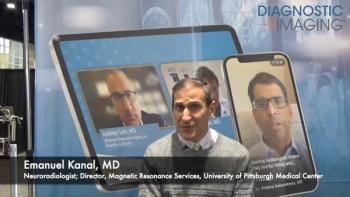
- Diagnostic Imaging Vol 30 No 11
- Volume 30
- Issue 11
Siemens' dual- and singlesource CTs reflect history
With patients' well-being in focus and dose reduction as a top priority, Siemens over the past three decades has introduced innovations in the way CT operates and how it is used.
With patients' well-being in focus and dose reduction as a top priority, Siemens over the past three decades has introduced innovations in the way CT operates and how it is used.
In 2005, the company introduced the Somatom Definition dual-source CT (DSCT). Through more than 400 DSCT installations over the past three years, Siemens has redefined the clinical role of CT by doubling temporal resolution, speed, and power. This scanner eliminates the need for beta blockers to reduce heartbeat frequency during CT heart examinations. Another major benefit is the ability to perform functional as well as anatomical imaging. Using dual energy with 10 applications, all cleared by the FDA, makes visible many pathologies that could not previously be detected. In combination with syngo WebSpace, this information can be interactively and instantaneously available to any department in a hospital, as well as to external locations.
In 2007, Siemens continued its evolution of single-source CT with the introduction of the Somatom Definition AS, the first truly adaptive CT scanner. Based on a fundamentally new way to use single-source CT, the Definition AS adapts on the fly to patients and their clinical needs, even the most challenging pediatric, obese, cardiac, or trauma cases. With its Adaptive 4D Spiral, it moves beyond fixed detector limitations to provide full 4D coverage of any organ. In stroke or tumor assessment, this provides invaluable functional information. With its built-in 3D, minimally invasive suite, Somatom Definition AS makes routine and complex procedures noticeably easier.
The road to these scanners was marked by the development of critical components, among them z-Sharp, which in 2003 pushed the boundaries of spatial resolution to a new level, producing routine isotropic resolution of 0.33 mm.
Just as Siemens has pursued advances in spatial and temporal resolution and functional wholeorgan and dual-energy imaging, so have we prioritized minimizing radiation dose. Over the years, Siemens has successfully integrated innovations that drastically reduce radiation dose.
The first giant step was achieved by our introduction of multislice CT in 1998. This was followed by the first ECG-pulsing system in 1999. Two years later, Siemens introduced Care Dose4D, the first completely automated x-ray exposure control. Another quantum improvement was reached with the introduction of DSCT, which drastically reduces cardiac dose to below even the level that can be achieved with coronary catheterization.
The latest Somatom Definition AS innovation in dose reduction is the Adaptive Dose Shield, a tubeside dynamic collimator that eliminates spurious radiation not usable for image reconstruction.
At Siemens research and development departments, we will continue to prioritize dose reduction, assuring both patients and medical personnel the best in medical care with the least possible risk. Siemens' next core innovation will once again make a difference to its customers by making CT exams much healthier for their patients.
Articles in this issue
about 17 years ago
Multicenter trial confirmsvalue of coronary CT angioabout 17 years ago
Siemens tweaks PET/CT T with hybrid for radiologyabout 17 years ago
GE Healthcare seeks better image quality, lower doseabout 17 years ago
Tech advisor CT vendors plot strategies for growthabout 17 years ago
Vendors polish advanced apps with 3T platformsabout 17 years ago
MRI spots anomalies in children with hearing lossabout 17 years ago
CT proves clinical worth in bowel obstruction casesabout 17 years ago
Strategies can limit imaging fungibilityabout 17 years ago
Smart probes and biomarkers spot earliest signs of cancerabout 17 years ago
MRA finds value in hydrocephalus interventionsNewsletter
Stay at the forefront of radiology with the Diagnostic Imaging newsletter, delivering the latest news, clinical insights, and imaging advancements for today’s radiologists.




























